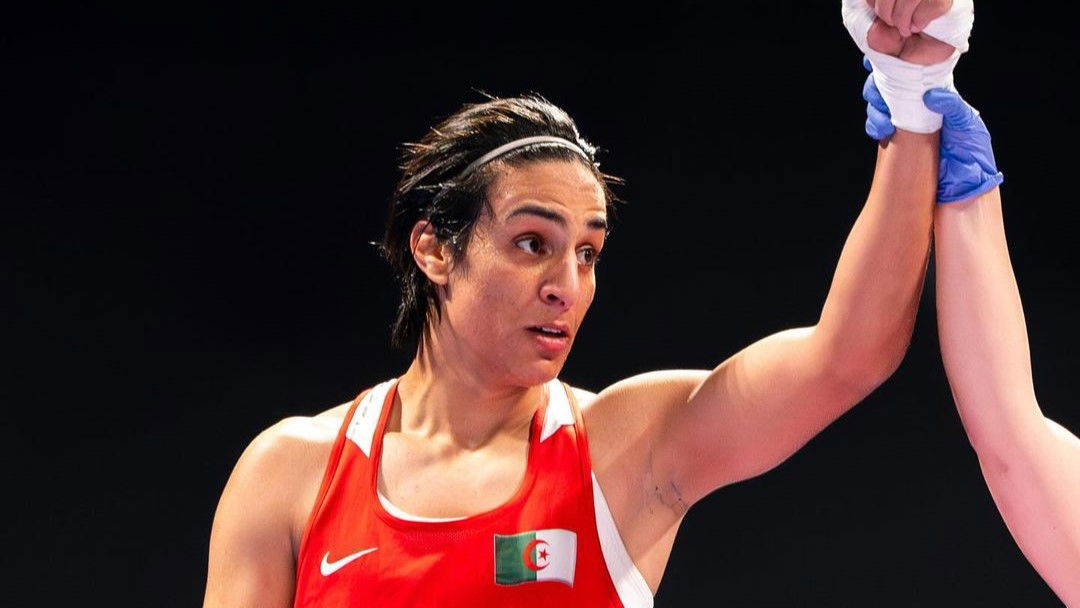
Imago
Image Source: Imane Khelif (Instagram)

Imago
Image Source: Imane Khelif (Instagram)
A powerful punch on the nose. That’s all Algerian Boxer Imane Khelif needed to bring down Italian boxer Angela Carini to her knees in the first-round match in the Paris Olympics. Little did Khelif know that instead of praise and applause for the win, outrage, and condemnation would come her way, sparking widespread outrage.
Watch What’s Trending Now!
Carini cried after the defeat within 46 seconds of the match as she withdrew from the bout after being hit. “I went to the ring to honor my father. I was told a lot of times that I was a warrior but I preferred to stop for my health. I have never felt a punch like this,” Carini stated tearfully in one of her media interviews. That is what started it all.
A massive public outcry led by popular figures like Elon Musk and J. K. Rowling ensued, which resulted in a vicious online crusade against the Algerian boxer who had just received her first win at the Olympics. But what caused it?
ADVERTISEMENT
Imane Khelif was disqualified by the International Boxing Association (IBA) from the Women’s World Boxing Championship last year, after having high testosterone levels and failing the IBA’s gender eligibility tests. Before the Olympics, the International Olympic Committee (IOC) conducted its own series of tests and, as a result, allowed her to compete in the women’s category at the Olympics.
Since then, the IBA and the public at large have been claiming that Imane Khelif is a biological male who should not have been allowed to compete in the women’s category at this year’s Summer Olympics. However, there is more to the story than meets the eye. Ignoring the usual social media trends, let’s explore the new developments that have come up that will help you view the Algerian boxer Imane Khelif in a new light, beyond the usual prejudices being peddled on the internet.
ADVERTISEMENT
What is Swyer Syndrome, the condition Imane Khelif allegedly suffers from?
It must be noted that Imane Khelif has never identified as biologically male, transgender, or intersex, and has always participated in various international competitions as a woman. It was based on their gender eligibility tests last year that the IBA surmised that Imane Khelif is not a woman since she has an XY chromosomal pair, which is the chromosomal pair present in a biological male. However, the story only begins there. It is certainly not the end.
The time has come to humanize the internet villain. It has now been reported that Imane Khelif suffers from a rare genetic condition called Swyer Syndrome or XY gonadal dysgenesis. According to Osmosis.org, individuals suffering from this condition have “a rare congenital disorder of s*x development.”
ADVERTISEMENT
To make things simpler, there is an evident disconnection between a person’s genetic makeup and their reproductive organs in some cases. In such cases, a person might have an XY (male) genetic makeup, but it leads to the development of a female reproductive system comprising a vagina, uterus, and fallopian tubes.
Top Stories
Greg Biffle Plane Tragedy: What Might Have Caused the Crash That Killed the NASCAR Champ and His Family

What Is Alycia Baumgardner’s Net Worth in 2025? Career Earnings, MVP Deal With Jake Paul, Biggest Purse & More

Jake Paul vs. Anthony Joshua Fight Purse: How Much Are Alycia Baumgardner and Others Earning?

Leila Beaudoin Relationship Status: Is the Canadian Boxer Married or Single?

Alycia Baumgardner Boyfriend/Husband: All About Her Relationship Status and Dating History

Jahmal Harvey vs. Kevin Cervantes Stats Comparison and Prediction: Record, Age, Height, Reach, Weight, Knockout Ratio, and Rankings

Vice versa may occur as well, where an individual with an XX (female) chromosomal pairing, might develop a male reproductive system. According to the National Institute of Health, the rare condition is caused by mutations of genes that are involved in the se*ual development of a fetus. The disorder is also reflected in the overall physical appearance of an individual.
ADVERTISEMENT
View this post on Instagram
What’s more, even though individuals with Swyer syndrome may develop a vagina and uterus, they do not have the corresponding sex glands, known as the ovaries. Therefore, the said person suffering from this rare disease is typically infertile and does not undergo puberty because of improper secretion of s*x hormones like estrogen and progesterone.
This is one reason why the IOC decided to disregard the IBA’s findings and allowed Imane Khelif to compete in the women’s category at the Olympics, just like she competed in the 2020 Tokyo Olympics as well. As things stand, the IOC stands firmly behind the Algerian boxer, claiming that Khelif complied with the entry regulations, and has been “competing in international boxing competitions for many years in the women’s category”.
ADVERTISEMENT
Furthermore, the Algerian Olympic Committee also condemned “the unethical targeting and maligning” of Khelif in light of the backlash that the athlete is receiving on social media. Now, taking into account the new developments in the story, Imane Khelif’s disqualification from last year’s international competition might make more sense.
Why was Imane Khelif disqualified from the World Championships?
Khelif was banned from the 2023 Women’s World Boxing Championship after she could not clear their gender eligibility criteria and she had high testosterone levels. The IBA stated previously that Khelif, along with Taiwanese boxer Lin Yu-ting, failed the DNA tests, returning an XY (male) chromosomal pairing.
ADVERTISEMENT
“Based on DNA tests, we identified a number of athletes who tried to trick their colleagues into posing as women. According to the results of the tests, it was proved that they have XY (male) chromosomes. Such athletes were excluded from competition,” the president of IBA, Umar Kremlev told Russia’s Tass news agency.
This has put the IBA and IOC at loggerheads now. Doubling down on their previous findings, and responding to the IOC’s accusation of making an “arbitrary decision” against the athletes, the IBA stated that the disqualification was based on two trustworthy tests conducted on both athletes by two independent laboratories during: 1) The IBA Women’s World Boxing Championships in New Delhi in 2023, and 2) The IBA Women’s World Boxing Championships in Istanbul in 2022.
Statement from the International Boxing Association:
The disqualification was based on two trustworthy tests conducted on both athletes in two independent laboratories as follows:
🔹Test performed during the IBA Women’s World Boxing Championships in Istanbul 2022.
🔹Test…— Boxing Kingdom (@BoxingKingdom14) August 2, 2024
ADVERTISEMENT
All in all, it is a very messy situation that has tainted the world of Olympic boxing. Nonetheless, there will be no disqualification and Imane Khelif will progress to the next round where she will go up against the Hungarian boxer Anna Luca Hamori. But does the scientific community support the concept of barring athletes with high testosterone levels from competing as females? A black-and-white answer has to come from them. Let us take a look at a development back in 2019.
Is the online hate a result of flawed scientific information?
The matter stirred up when the University of Colorado, Boulder, in 2019, challenged the validity of a 2017 study by World Athletics (then IAAF). Based on that study, in April 2018, the international governing of track and field announced new regulations requiring certain female athletes with naturally high testosterone levels to take testosterone-lowering hormones for competing in the women’s category for the 400m, the 400m hurdles, the 800m, the 1500m, and the one mile. The study was published in the British Journal of Sports Medicine (BJSM).
ADVERTISEMENT
However, in 2019, a team at UC Boulder, led by Roger Pielke Jr., director of the Center for Sports Governance at the university, published a new paper in The International Sports Law Journal. It declared the results of the 2017 paper were “fatally flawed.” They claimed that as they tried to replicate the findings of the previous study using data from it, they found that 17 to 32 percent of the data used was faulty.
“Any agency, in sport or beyond, should be expected to produce science that can withstand scrutiny and which actually supports the justification for proposed regulations. That simply did not happen here,” Pielke had said on that occasion. Looking at these, it seems as if much clarity and debate are still left to settle the matter. Going through all these, has your perspective on the controversy changed? Let us know in the comment section below.
ADVERTISEMENT
ADVERTISEMENT
ADVERTISEMENT

